In 1989 when Bajaj came out with their legendary and elegant Hamara Bajaj campaign, that looked more at apna India, rather than the scooter, and at all hues of scootered Indians, it drew millions of eyeballs and was brilliantly successful.

The idea of selling a brand by selling the Idea of India is not new.
It was probably nearly brand new in the late 1980s.
Back then, in the Age of the Sing-Song 2-Minute Maggi Commercials, as India's television channels started expanding, television spots advertising products focused on their attributes.
Think: Washing powder Nirma or the Liril Girl or Pan Parag.
So, in 1989 when Bajaj came out with their legendary and elegant Hamara Bajaj campaign, that looked more at apna India, rather than the scooter, and at all hues of scootered Indians, it drew millions of eyeballs and was brilliantly successful.
The fact that the words and tune of the Hamara Bajaj jingle had a beguiling sare-jahan-se-accha kind of cadence to it added tremendously to its success.
There were many players behind this high-profile ad blitz -- that is the folks responsible for the triumph of the campaign, that won several awards.
The key person was, of course, Rahul Bajaj, chairman of the Bajaj group of companies, who had the gumption to gamble on such a hatke approach to selling one of his top products.
In this two-part feature Vaihayasi Pande Daniel/Rediff.com asked four of the people who worked, sleeves rolled up, on the Hamara Bajaj campaign -- Rahul daCunha, Sumantra Ghosal, Jaikrit Rawat, Prashant Godbole -- to recollect how it came about and what the passing of the affable industry doyen Rahul Bajaj, who signed off on the Hamara Bajaj effort, meant to them.
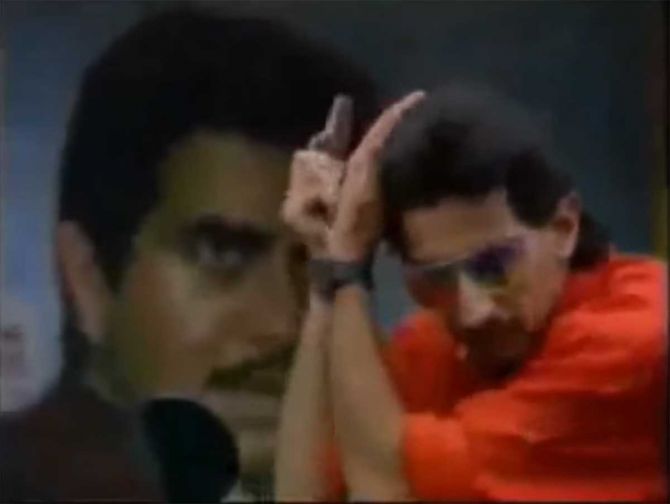
Rahul daCunha
Then: Copywriter, Lintas.
Today: Head, daCunha Communications, theatreman, playwright, part of the Amul ad team.
Rahul daCunha recalls that Bajaj was in the market for a unique ad campaign that could arm India's darling scooter against the new two-wheeler models arriving on Indian shores from abroad.
"We knew that the campaign for the Bajaj scooter needed -- in modern terminology -- an X Factor to be able to take it out of what I loosely call (the realm of) regular transportation, because we didn't necessarily have a scooter that could match the incoming competition or the features to be able to fully attract a younger audience."
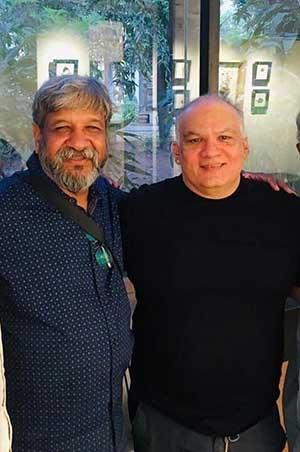 IMAGE: Prashant Godbole, left, with Rahul daCunha. Photograph: Kind courtesy Prashant Godbole
IMAGE: Prashant Godbole, left, with Rahul daCunha. Photograph: Kind courtesy Prashant GodboledaCunha's boss was the talented late creative director Kersy Katrak, who founded MCM creative agency and was considered the 'father of creative advertising' in India.
"Kersy's point to us was: 'Look, we need to come up with a campaign that's like Chevrolet's Heartbeat of America campaign'. That campaign for Chevrolet kind of took on the Japanese invasion (of new cars in America). He said the only way we could do that was by coming up with a campaign that really created a sense of nostalgia in the Indian."
daCunha believes that such kind of thinking was new at the time in the country and spawned a subsequent progeny of feel-good-about-India advertising. "Therefore, it became more difficult to sell, because it was the first. Clients were so used to brand campaigns that were straightforward and direct. If you are, selling a motorcycle, then tell me it's a motorcycle, right?... Nobody was really into the fact that: 'Let's take it out of mere transportation into the larger canvas of India'."
And that's exactly what they did. "We talked about it as being not just a scooter, but the fact that it addresses the whole of India. It's not Mera Bajaj, but Hamara Bajaj." They highlighted a non-factory made feature or 'emotional benefit' of the product.
Hectic brainstorming followed at Lintas to find images to match this fresh direction for an ad campaign: "We asked: 'What are the kinds of shots that we can show, that aren't cliched shots of the scooter just being driven by people?' Typically, Parsis are very, very possessive about their scooters. And then we had this sort of filmi kind of guy combing his hair in the scooter's mirror. Each of the shots became quite specific to India."

Before heading up to Pune to show what they could put together to Mr Bajaj, they did a kind of storyboard. "We also did a scratch recording, because we knew that the song was kind of powerful -- buland Bharat ki buland tasveer is quite a powerful line."
"Mr Bajaj liked it," daCunha recalls. "I think it takes a guy like that to really to see the big picture. Usually, it's the head of a company who is able to see the broader appeal of what we were trying to say."
DaCunha, Prashant Godbole and the Lintas team made an exhaustive presentation. "He was quick to decide. His point was simply this: 'Look, if you guys believe it is going to work -- I think it's a bit off the wall -- but if you guys believe that it's going to have impact, let's see."

DaCunha remembers: "He was this other kind of client who says yes (because he realises that with) any decision you take, as much as you research it, it can only be half right and half wrong. You can't really ever punt on anything that's 100 per cent."
And it scored a near perfect 100 per cent.
DaCunha doesn't recall what Bajaj had to say about the success of the campaign. But they all were very happy with it, "Because they ran it for a long time. The good thing was that (the campaign) caught on immediately; the song just caught on. At that time, we didn't really have many television stations, right. There was only DD. And we kicked ass."
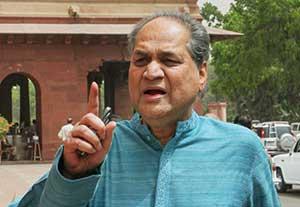 IMAGE: Rahul Bajaj. Photograph: PTI Photo
IMAGE: Rahul Bajaj. Photograph: PTI PhotoNot only that, Rahul Bajaj gained a fan for life. Says daCunha, "I absolutely loved him. He was so -- I can't tell you -- he was so humble. He had kind of mischief about him. You kind of realised that there is a sense of humor there. I think he didn't take his stature and his wealth that seriously.
"He was the kind of guy that I wish I could have always had as a client. A client, who like all great clients, (believed) if we have hired you as experts, then let's let you do what you need to do and don't interfere with the creative guys."

Proof that Hamara Bajaj was a groundbreaking project lies in the fact that it's still not forgotten. "To this day, even years after they (Bajaj Auto) abandoned the Hamara Bajaj tagline, people still remember it."
DaCunha continued to have some amount of trucking with Rahul Bajaj on future products like the Kawasaki Bajaj motorcycle. "We actually had a really good time at a dealer conference, I think two years later, where he (Rahul Bajaj) was going to unveil a motorcycle.
"We did this slightly stagey kind of presentation, which needed him to not act, but be kind of cool. He was up for it. A lot of guys can get a bit stage frightened and say: 'No, I can't do that'. But he was up for it. He was up for the challenge. And he enjoyed it."
There were other things too that set him apart from the various who's who daCunha dealt with through his career. "He had swag. That was what carried him. A lot of clients, that I've met over the years, have done well for themselves and they let you know that they're doing well for themselves. Mr Bajaj was just so easy about it. He seemed outwardly so calm and casual. Which is a rare quality."
A man who wasn't full of himself? "No, not all. It helped that he lived in Pune. He was away from this stuff (in Mumbai). I always felt there was this sense of humility about the man. There was no sense of entitlement. He just seemed like a very humble man."

Sumantra Ghosal
Then: Ad film-maker.
Now: Film-maker, documentary maker, director of The Speaking Hand, The Unseen Sequence.
The work Sumantra Ghosal did as a film-maker on the Hamara Bajaj film, he says, stands out the most, although his career is dotted with lots of other stuff of HB calibre. "In my advertising career, it's probably something that marks me out for praise, or condemnation, as you will."
Ghosal was approached with the concept and idea for the Bajaj blitz by Lintas. "They wanted me to Indianise it -- it was not an original concept, I must say, as many things in India are not, unfortunately. It was then left to me to do what I pleased, because by then I think people had begun to trust me, silly asses. And that's how it worked."
"I then took that concept and I wrote a jingle for it together with a colleague of mine, Jaikrit Rawat, who was a very fine writer. I devised the music for it with my cameraman Barun Mukherjee. We passed on what we decided -- because Barun could sing -- to Louis Banks, who was an extraordinary music composer, and still is a great jazz pianist. And so, it came about sort of in the way that these things happen."
When he was working on this project for Bajaj did Ghosal ever imagine it would become so iconic? Amusedly: "Are you stark raving mad? Of course not. We were silly people making ads. We certainly had no idea what the word iconic meant. And the fact that it has become (that) -- it's sort of still remembered, now, what 32 years later -- is extraordinary."
But he partially attributes that to it being 1989 when there were not so many television ads about. "There was not that much information overload, as there is today, where people hardly remember their own names," Ghosal adds dryly.
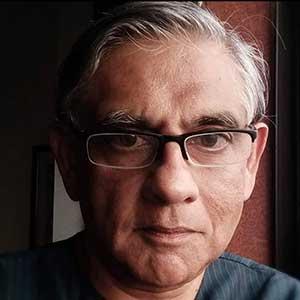 IMAGE: Sumantra Ghosal. Photograph: Kind courtesy Sumantra Ghosal
IMAGE: Sumantra Ghosal. Photograph: Kind courtesy Sumantra GhosalThe Hamara Bajaj ad film and campaign he feels had three aspects that made it quite distinctive. "It was in a sense original, because for the first time -- I don't know whether it was for the first time, because these are things people say without any real knowledge -- but certainly we were among the first to cast unknown people off the street for the film.
"Unknown people who were everyday -- who were, therefore, the boy next door, the man next door, the girl next door. That was novel for the times and turned out to be endearing -- at the time it was mainly stars, as it is today, and models, as it is not today."
Secondly, the jingle, which was worked with an Indian raag, even though it was orchestrated, generated its own breathtaking quotient of magic. "Between my cameraman and my music director, a jingle was made, which was sung by a man named Vinay Mandke. The jingle became very, very memorable. People would hum it."
Ghosal considers that the two words coined for the campaign was its third special feature. "Hamara Bajaj. Nobody would (eventually) remember the film, and people who have not even seen the film still echoed those two words. The power of words continued then and continues today."

The film-maker says thoughtfully that he is also of the opinion that while the Hamara Bajaj theme kindled a pride in being Indian, it wasn't over the top or bursting with kitschy misplaced patriotism.
"It was novel, but it was not jingoistic, which a lot of what we are doing today is. That sort of helped. It stirred some sort of national pride.
"What sets it (the Bajaj ad film/the campaign) apart from what is happening today, in the name of nationalism, is that it brought many communities together in the ad, which is a different form of nationalism to one that always looks at the outsider within, or looks at the threat from within.
"Bajaj obviously didn't do any of that. And therefore, I think in that sense, it was an optimistic nationalism, as opposed to today, which is a rather pessimistic nationalism."
And the tone matched the strategy Rahul Bajaj was trying to or needed to achieve to face foreign competition. "Bajaj wanted to stir up a kind of national pride -- Make In India, before the advent of that term, in a more fascist sort of way. All those things were, in a sense, prescient, and certainly at that point, it helped the brand. And it helped the film get its popularity, as well."
Unlike daCunha and the Lintas team, Ghosal had no direct contact with Bajaj. "My interactions with him were precisely nil. I was a lowly film-maker, he was a highly placed industrialist -- these two very rarely combined. And we didn't.
"When he passed away, I had no real feelings since I didn't know him at all. I knew him to be a man of principle; I knew him to be a man of spine, which most industrialists may not possess today."
"Therefore, there was the feeling that a person from an earlier time had passed, and, maybe, had not left too much of a legacy behind for the new era.
Look out for Part II: Prashant Godbole and Jaikrit Rawat speak to Vaihayasi Pande Daniel/Rediff.com about Mr Rahul Bajaj.
Feature Presentation: Ashish Narsale/Rediff.com
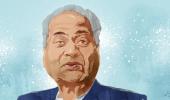

.jpg)







